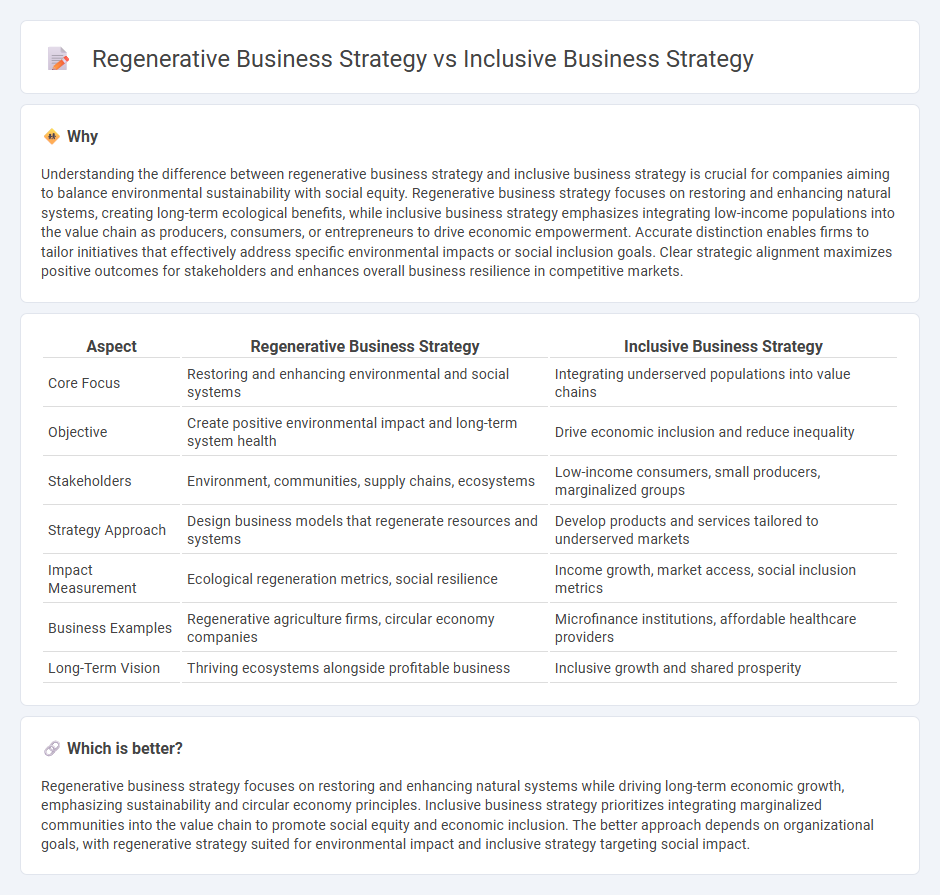
Regenerative business strategy focuses on restoring ecosystems and enhancing social equity through sustainable practices that go beyond traditional corporate responsibility. Inclusive business strategy emphasizes integrating marginalized communities into the value chain as suppliers, employees, or customers to drive shared economic growth. Discover how these approaches can transform your consulting projects and create lasting impact.
Why it is important
Understanding the difference between regenerative business strategy and inclusive business strategy is crucial for companies aiming to balance environmental sustainability with social equity. Regenerative business strategy focuses on restoring and enhancing natural systems, creating long-term ecological benefits, while inclusive business strategy emphasizes integrating low-income populations into the value chain as producers, consumers, or entrepreneurs to drive economic empowerment. Accurate distinction enables firms to tailor initiatives that effectively address specific environmental impacts or social inclusion goals. Clear strategic alignment maximizes positive outcomes for stakeholders and enhances overall business resilience in competitive markets.
Comparison Table
| Aspect | Regenerative Business Strategy | Inclusive Business Strategy |
|---|---|---|
| Core Focus | Restoring and enhancing environmental and social systems | Integrating underserved populations into value chains |
| Objective | Create positive environmental impact and long-term system health | Drive economic inclusion and reduce inequality |
| Stakeholders | Environment, communities, supply chains, ecosystems | Low-income consumers, small producers, marginalized groups |
| Strategy Approach | Design business models that regenerate resources and systems | Develop products and services tailored to underserved markets |
| Impact Measurement | Ecological regeneration metrics, social resilience | Income growth, market access, social inclusion metrics |
| Business Examples | Regenerative agriculture firms, circular economy companies | Microfinance institutions, affordable healthcare providers |
| Long-Term Vision | Thriving ecosystems alongside profitable business | Inclusive growth and shared prosperity |
Which is better?
Regenerative business strategy focuses on restoring and enhancing natural systems while driving long-term economic growth, emphasizing sustainability and circular economy principles. Inclusive business strategy prioritizes integrating marginalized communities into the value chain to promote social equity and economic inclusion. The better approach depends on organizational goals, with regenerative strategy suited for environmental impact and inclusive strategy targeting social impact.
Connection
Regenerative business strategy focuses on restoring ecosystems while creating long-term value, which aligns with inclusive business strategy's goal of integrating marginalized communities into economic growth. Both strategies emphasize sustainability and social equity, driving innovation that benefits the environment and society simultaneously. This connection fosters resilient business models that generate shared value and enhance stakeholder engagement.
Key Terms
Stakeholder Engagement
Inclusive business strategy prioritizes engaging a diverse range of stakeholders, including marginalized communities and underrepresented groups, to create economic opportunities and foster shared value. Regenerative business strategy deepens stakeholder engagement by integrating ecological and social system restoration, ensuring that business activities contribute positively to the environment and community resilience. Discover how aligning stakeholder engagement with these strategies drives sustainable growth and long-term impact.
Social Impact
Inclusive business strategies prioritize integrating marginalized communities into the supply chain to foster economic opportunities and reduce inequalities, emphasizing measurable social impact and equitable growth. Regenerative business strategies extend beyond sustainability by actively restoring social and environmental systems, aiming for long-term resilience and holistic societal well-being. Explore how these approaches differ in driving social impact and transforming business models.
Circular Economy
Inclusive business strategy emphasizes integrating marginalized communities into the value chain to create economic opportunities and reduce inequalities, while regenerative business strategy aims to restore and enhance natural ecosystems through sustainable practices aligned with the Circular Economy principles. Both strategies promote resource efficiency and waste reduction, yet regenerative business focuses more on replenishing environmental capital beyond sustainability. Explore how these approaches drive innovation and resilience in circular economic models for a sustainable future.
Source and External Links
Inclusive Business: from Experimentation to Scale - A strategy for inclusive business involves embedding social impact into core objectives to ensure long-term sustainability and growth, with key steps including clarifying business cases, leadership engagement, successful piloting, strong governance, and mainstreaming inclusive practices across the organization.
Inclusive business model - This model creates value for low-income communities by integrating them into a company's value chain as consumers or producers, emphasizing human development impact, self-sustainability, and environmental responsibility to balance social value and profitability.
Inclusive Business | Focus Areas - Inclusive business strategies help companies leverage diverse talent, foster innovation, and build trust by developing credible, scalable policies and governance that support economic inclusion and yield long-term business and societal value.
 dowidth.com
dowidth.com